Sustainability and the Expected Effects of Office-to-Residential Conversion in Historic Downtown Areas of South Korea
Abstract
1. Introduction
2. Urban Regeneration New Deal Project of South Korea
3. Historic Downtown Revitalization in Korea
3.1. Decline of Historic Downtown Areas
3.2. Historic Downtown Housing
4. Methods
4.1. Urban Decline Indicators
4.2. Subject Area
5. Results
5.1. Population Change Rate
5.2. Aging Buildings
5.3. Number of Industries and Employees
5.4. Office Vacancy
5.5. Urban Housing Demand
6. Findings and Discussion
6.1. Sustainable Recovery of Urban Space
6.2. Sustainably Increasing Urban Population and Industries
7. Conclusions
Author Contributions
Funding
Conflicts of Interest
References
- Vojnovic, I. Urban sustainability: Research, politics, policy and practice. Cities 2014, 41, S30–S44. [Google Scholar] [CrossRef]
- Toli, A.; Murtagh, N. Environmental Sustainability Indicators in Decision-Making Analysis on Urban Regeneration Projects: The Use of Sustainability Assessment Tools. In Proceedings of the ARCOM 2017 Conference, Cambridge, UK, 4–6 September 2017; Volume 33, p. 10. [Google Scholar]
- Colantonio, A.; Dixon, T. Urban Regeneration and Social Sustainability: Best Practice from European Cities; Wiley-Blackwell: Chichester, UK, 2011; pp. 1–17. [Google Scholar]
- Dawodu, A.; Akinwolemiwa, B.; Cheshmehzangi, A. A conceptual re-visualization of the adoption and utilization of the Pillars of Sustainability in the development of neighborhood sustainability assessment tools. Sustain. Cities Soc. 2017, 28, 398–410. [Google Scholar] [CrossRef]
- Lang, T. Insights in the British Debate about Urban Decline and Urban Regeneration; Leibniz Institute for Research on Society and Space: Erkner, Germany, 2005; p. 25. [Google Scholar]
- Priority Actions Programme. Guidelines for Urban Regeneration in the Mediterranean Region; Priority Actions Programme: Split, Croatia, 2004; Available online: https://www.pap-thecoastcentre.org/pdfs/Urban%20Regeneration.pdf (accessed on 24 June 2020).
- Roberts, P. Evolution, Definition and Purpose of Urban Regeneration. In Urban Regeneration, 2nd ed.; Roberts, P., Granger, H., Sykes, R., Eds.; Sage: London, UK, 2017; pp. 9–44. [Google Scholar]
- Mateo, C.; Cuñat, A. Guide of strategies for urban regeneration: A design-support tool for the Spanish context. Ecol. Indic. 2016, 64, 194–202. [Google Scholar] [CrossRef]
- La Rosa, D.; Riccardo, P.; Barbarossa, L.; Greca, P.L. Assessing spatial benefits of urban regeneration programs in a highly vulnerable urban context: A case study in Catania, Italy. Landsc. Urban Plan. 2017, 157, 180–192. [Google Scholar] [CrossRef]
- Ball, M.; Maginn, P.J. Urban Change and Conflict: Evaluating the Role of Partnerships in Urban Regeneration in the UK. Hous. Stud. 2005, 20, 9–28. [Google Scholar] [CrossRef]
- Kim, S.T. Analysis of the problems of donut phenomenon and measures to activate historic downtown. J. Resi. Environ. Inst. Korea 2007, 5, 223–243. [Google Scholar]
- Law on Planning and Utilization of National Territory. Available online: http://www.law.go.kr/LSW/lsSideInfoP.do?lsiSeq=51459&joNo=&joBrNo=&docCls=&urlMode=lsRvsDocInfoR&chrClsCd=010201 (accessed on 24 March 2020).
- Special Act on the Revitalization and Support of Urban Regeneration. Available online: http://www.law.go.kr/lsInfoP.do?lsiSeq=149567#0000 (accessed on 24 March 2020).
- National Law Information Center. Enforcement Decree of the Special Act on Promotion of and Support for Urban Regeneration. Available online: http://www.law.go.kr/LSW/eng/engLsSc.do?menuId=2§ion=lawNm&query=Urban+Regeneration&x=0&y=0#liBgcolor0 (accessed on 29 June 2020).
- Urban Regeneration Information System. What is the Urban Regeneration New Deal? Available online: https://www.city.go.kr/portal/policyInfo/newDeal/contents02/link.do (accessed on 28 June 2020).
- Urban Regeneration New Deal. Korea Policy Briefing. Available online: https://www.korea.kr/special/policyCurationView.do?newsId=148863980#L1 (accessed on 28 June 2020).
- Fol, S.; Cunningham-Sabot, E. Urban Decline and Shrinking Cities: A Critical Assessment of Approaches to Urban Shrinkage. Ann. Géogr. 2010, 674, 359–383. [Google Scholar] [CrossRef]
- Lee, S.D. The Urban Rehabilitation Problem and the Expansion Strategy of Urban Housing Function. Plan. Policy 2004, 9, 36–45. [Google Scholar]
- Beauregard, R. The Textures of Property Markets: Downtown Housing and Office Conversions in New York City. Urban Stud. 2005, 42, 2431–2445. [Google Scholar] [CrossRef]
- Choi, H.I.; Yim, M.H. Housing Policy for the Prevention of Urban Hollowing-out. J. Korean Policy Stud. 2005, 12, 127–150. [Google Scholar]
- Artibise, A. The Path to Sustainable Development in Metropolitan Regions: Federal and State Roles. In Revitalizing the City: Strategies to Contain Sprawl and Revive the Core, 1st ed.; Routledge: New York, NY, USA, 2005; pp. 410–416. [Google Scholar]
- Heath, T. Adaptive re-use of offices for residential use: The Experiences of London and Toronto. Cities 2001, 18, 173–184. [Google Scholar] [CrossRef]
- Roberts, P. Housing. In Urban Regeneration, 2nd ed.; Edgar, B., Taylor, J., Eds.; Sage: London, UK, 2017; pp. 153–170. [Google Scholar]
- Winston, N. Urban Regeneration for Sustainable Development: The Role of Sustainable Housing? Eur. Plan. Stud. 2009, 17, 1781–1796. [Google Scholar] [CrossRef]
- Priemus, H.; ten Heuvelhof, E. The long way to sustainable housing areas. Environ. Plan. B Urban Anal. City Sci. 2005, 32, 1–3. [Google Scholar] [CrossRef]
- Urban Regeneration Information System. Urban Decline Indicators of Korea. Available online: https://www.city.go.kr/portal/policyInfo/urban/contents01/link.do (accessed on 24 March 2020).
- Korean Statistical Information Service. Population Census. Available online: http://kosis.kr/eng/statisticsList/statisticsListIndex.do?menuId=M_01_01&vwcd=MT_ETITLE&parmTabId=M_01_01&statId=1962001&themaId=#A_4.2 (accessed on 24 February 2020).
- Schuurmans, A.; Dyrbøl, S.; Guay, F. Buildings in Urban Regeneration. IntechOpen 2018, 41–59. [Google Scholar] [CrossRef]
- Remøy, H.; Van der Voordt, T. A new life: Conversion of vacant office buildings into housing. Facilities 2006, 25, 88–103. [Google Scholar] [CrossRef]
- Remøy, H.; Van der Voordt, T. Adaptive reuse of office buildings: Opportunities and risks of conversion into housing. Build. Res. Inf. 2014, 42, 381–390. [Google Scholar] [CrossRef]
- Building Life History Management System, Ministry of Land, Infrastructure and Transport. Available online: https://blcm.go.kr/cmm/main/mainPage.do (accessed on 24 March 2020).
- Korean Statistical Information Service (KOSIS). Number of Industries, Number of Employees by City, City, Industry, and Business. Available online: http://kosis.kr/statHtml/statHtml.do?orgId=101&tblId=DT_1K52C01&conn_path=I3 (accessed on 24 February 2020).
- Korean Statistical Information Service (KOSIS). Office Vacancy Rate by Commercial District. Available online: http://kosis.kr/statHtml/statHtml.do?orgId=408&tblId=DT_40801_N120201_01&conn_path=I3 (accessed on 24 February 2020).
- Korean Statistical Information Service (KOSIS). Average Initial Sales Rate of Apartments by Region. Available online: http://kosis.kr/statHtml/statHtml.do?orgId=414&tblId=DT_41401N_008&conn_path=I3 (accessed on 24 February 2020).
- Korean Statistical Information Service (KOSIS). Housing Supply Rate. Available online: http://kosis.kr/statHtml/statHtml.do?orgId=116&tblId=DT_MLTM_2100&conn_path=I2 (accessed on 24 February 2020).
- Barlow, J.; Gann, D. Flexible Planning and Flexible Buildings: Reusing Redundant Office Space. J. Urban Aff. 1995, 17, 263–276. [Google Scholar] [CrossRef]
- Bullen, P. Adaptive reuse and sustainability of commercial buildings. Facilities 2007, 25, 20–31. [Google Scholar] [CrossRef]
- Jacobs, J. Death and Life of Great American Cities; Random House: New York, NY, USA, 1961; pp. 188–189. [Google Scholar]
- Kim, E.K.; Lee, S.H. A Study on the Solution of the Offices Vacancy through Overseas Cases of Office-to-Mixed Use Conversion. J. Korean Hous. Assoc. 2019, 12, 93–102. [Google Scholar]
- Ju, D.H.; Kim, J.J. A Study on the Factors Affecting the Vacancy Rate of the Office using VECM. J. Res. Environ. Inst. Korea 2016, 6, 93–108. [Google Scholar]
- Sivitanides, P. The Rent Adjustment Process and the Structural Vacancy Rate in the Commercial Real Estate Market. J. Real Estate Res. 1997, 13, 195–209. [Google Scholar]
- Sanderson, B.; Farrelly, K.; Thoday, C. Natural vacancy rates in global office markets. J. Prop. Invest. Finan. 2006, 24, 490–520. [Google Scholar] [CrossRef]
- Korean Statistical Information Service (KOSIS). Basic Information of Offices by Business District. Available online: http://kosis.kr/statHtml/statHtml.do?orgId=408&tblId=DT_40801_N1101&conn_path=I3 (accessed on 24 February 2020).
- Friedrichs, J. A Theory of Urban Decline: Economy, Demography and Political Elites. Urban Stud. 1993, 30, 907–917. [Google Scholar] [CrossRef]
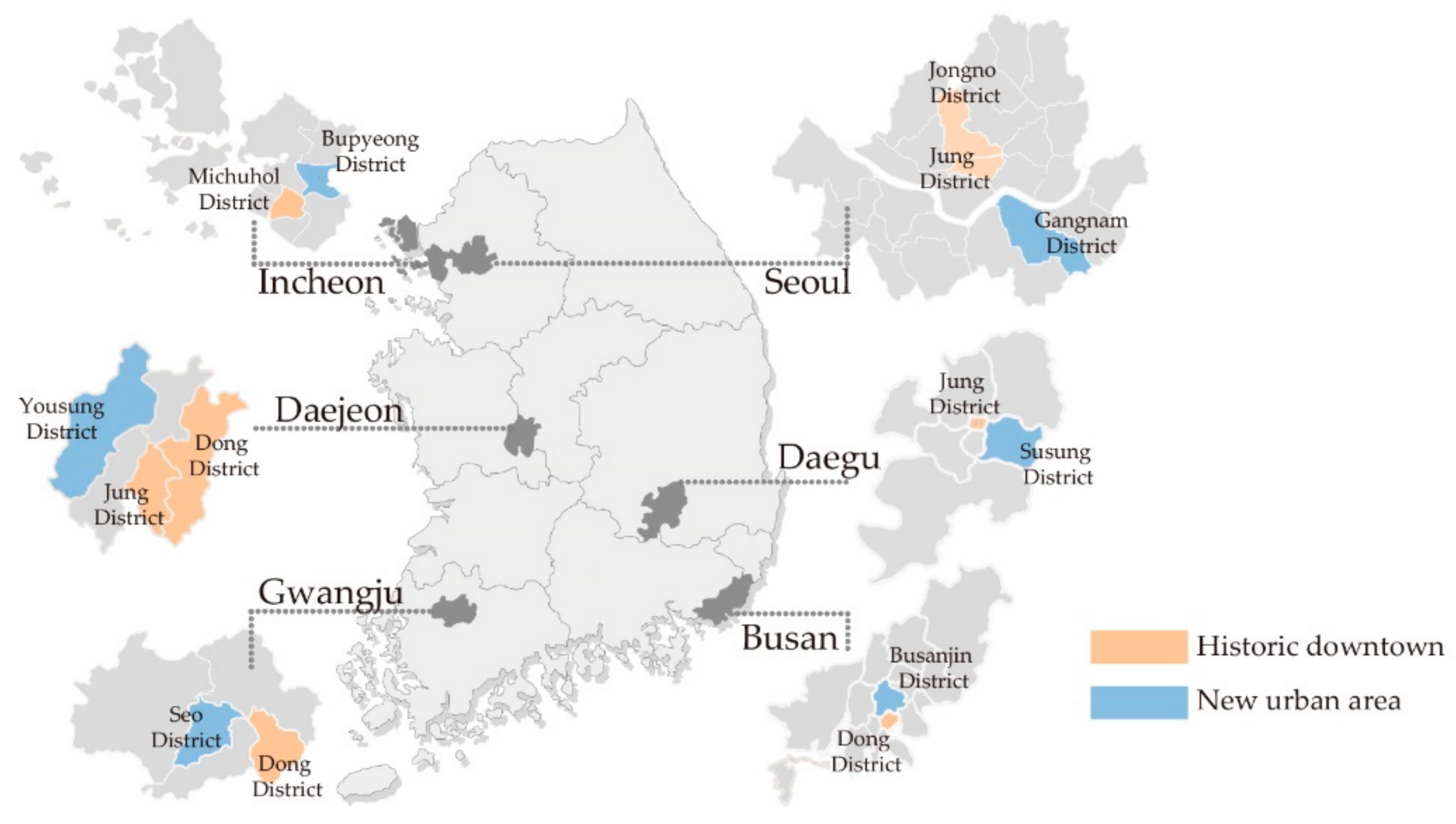
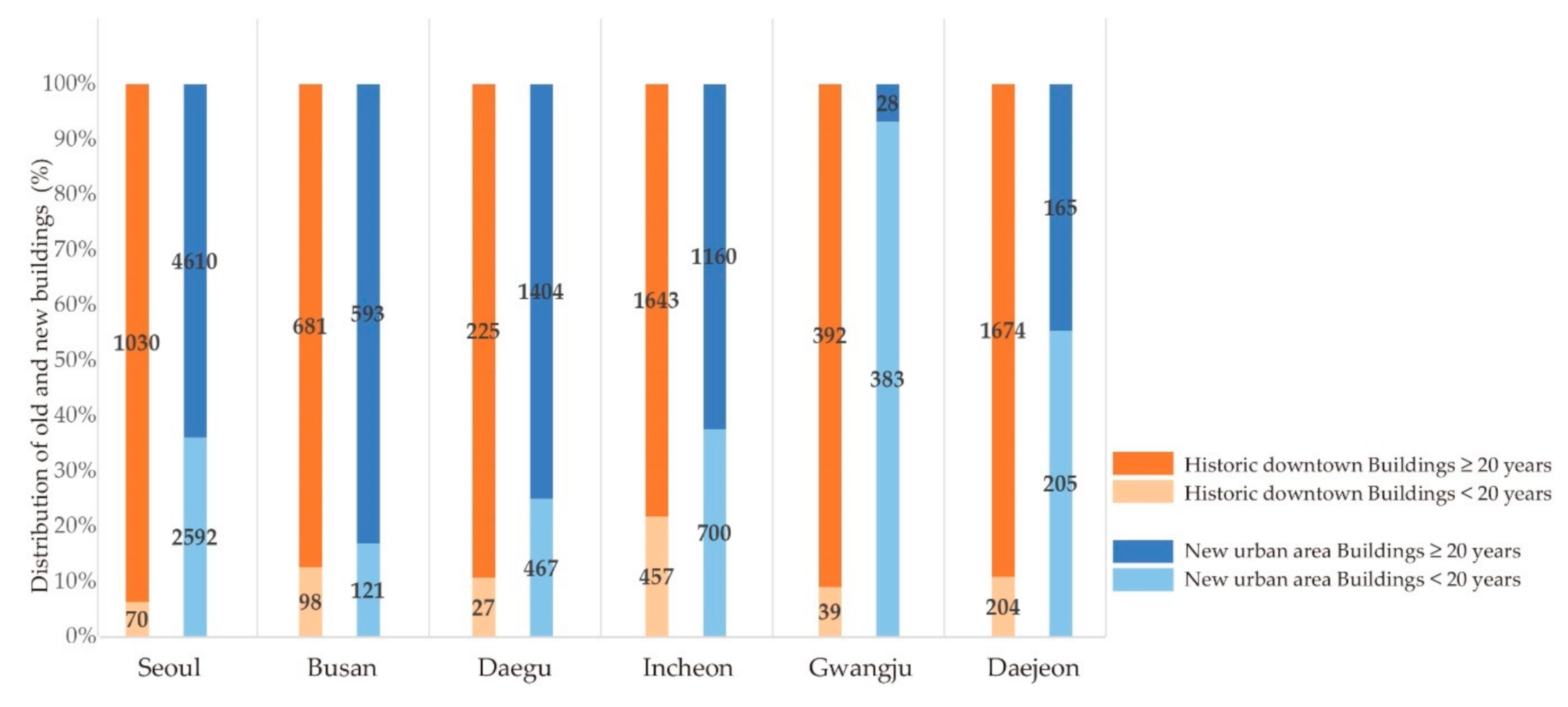
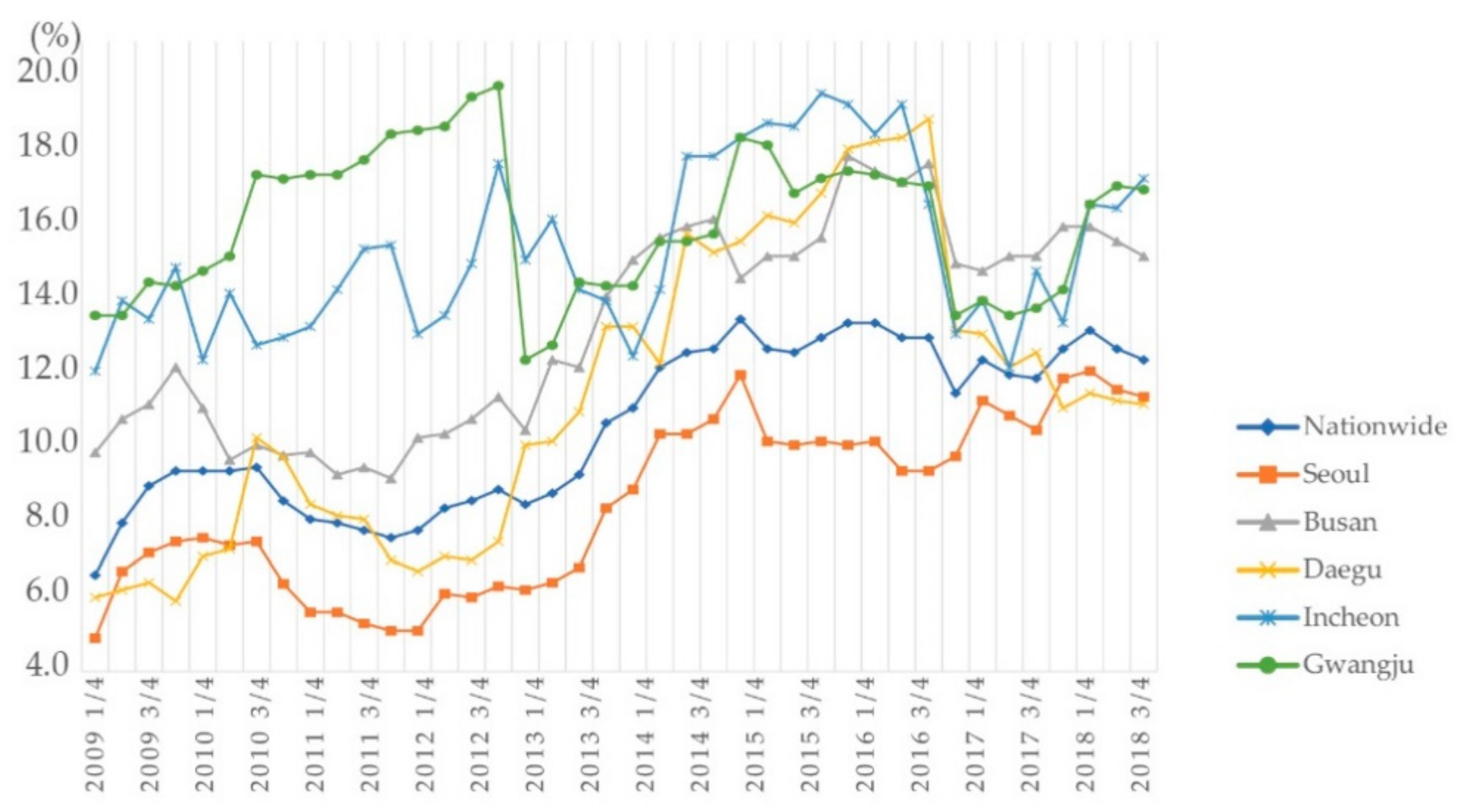
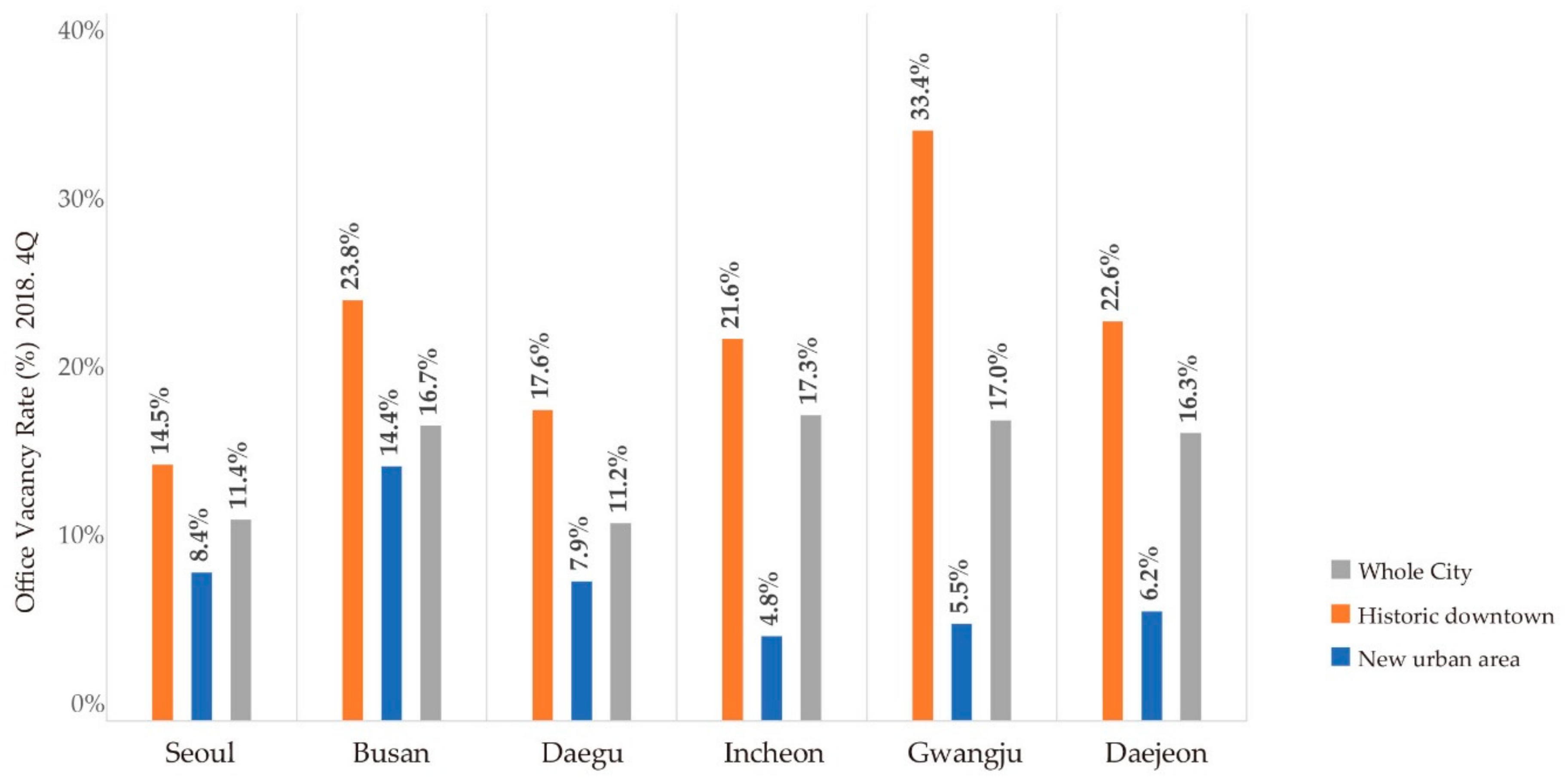
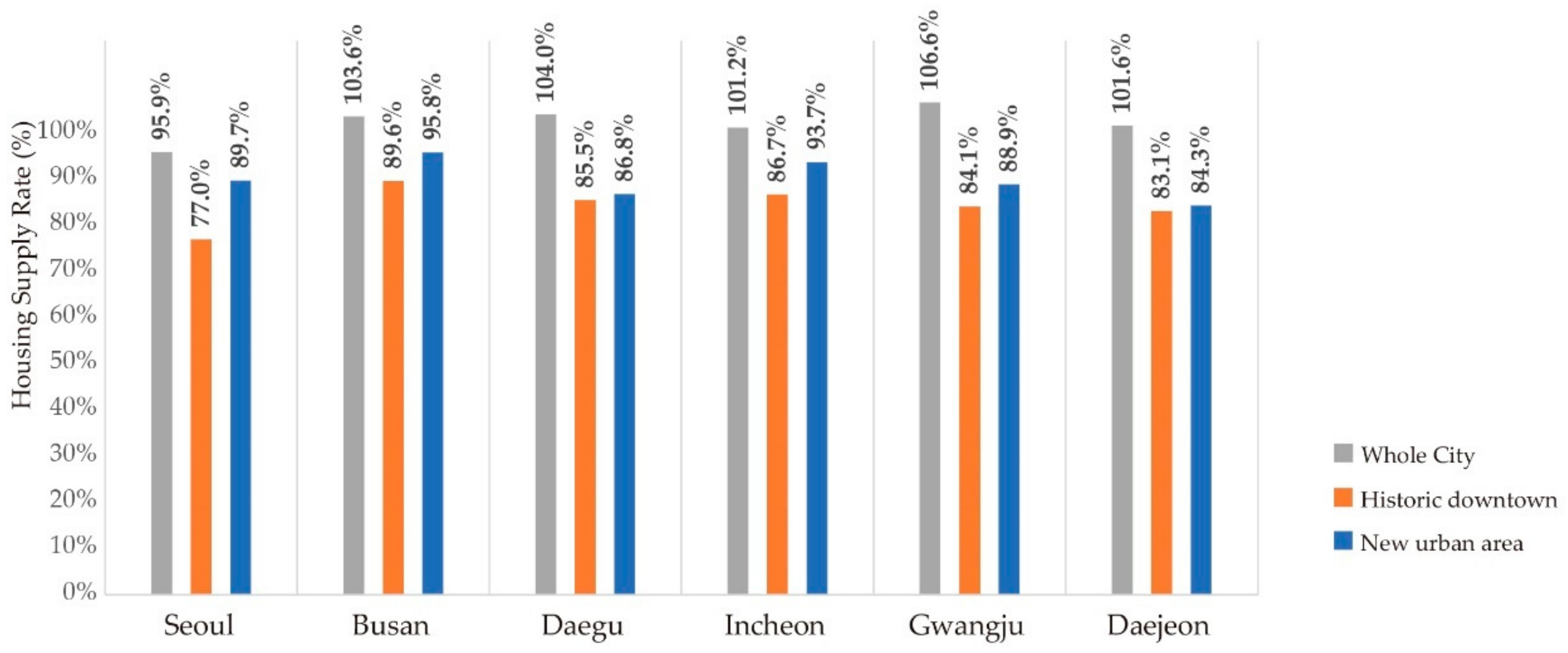
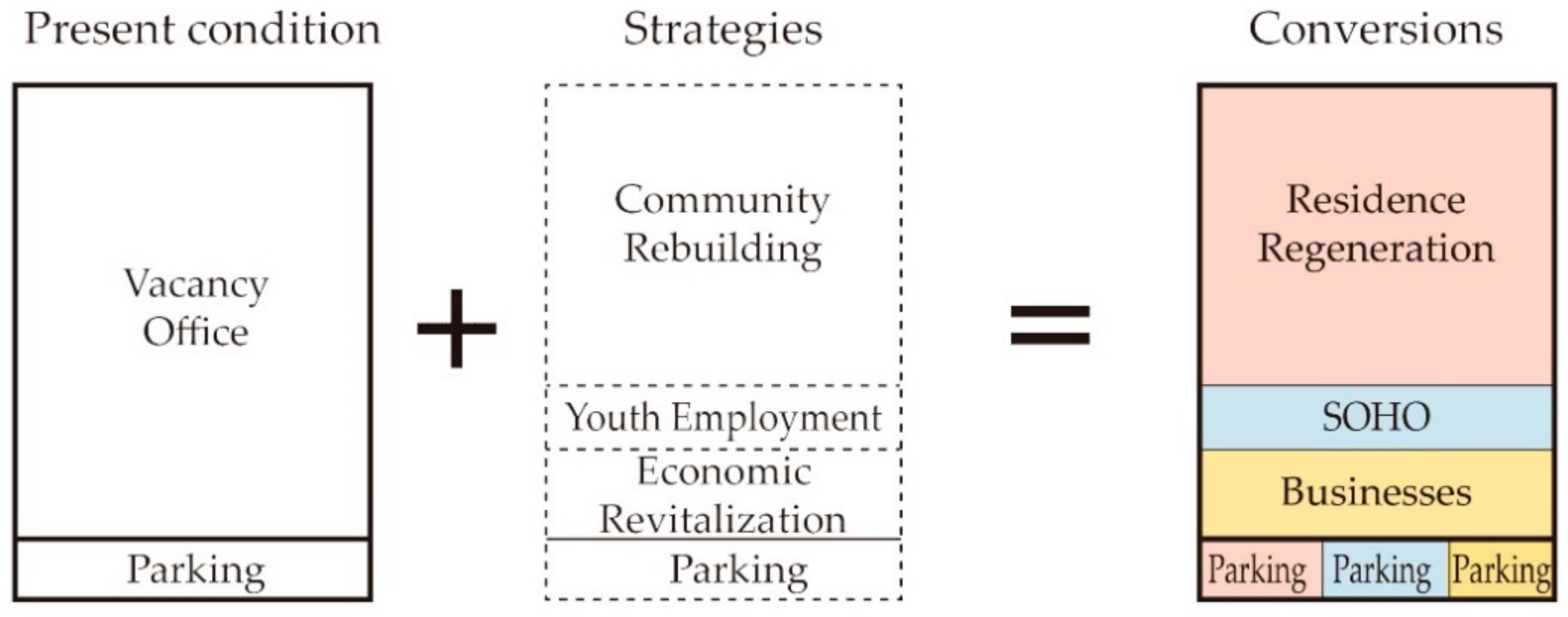
| Policy Goal | 3 Strategies | 5 Major Projects |
|---|---|---|
| Improving the quality of life and restoring urban vitality | Urban space innovation | Improvement of residential environments in old residential areas |
| Establishing historic downtown areas as an innovation base | ||
| Creating new jobs | Urban regeneration economy activation | Activation of urban regeneration economic organization/Inducing private participation |
| Community recovery and social integration | Residential and local initiatives | Construction for urban regeneration governance |
| Gentrification proactive responses |
| Cities/Area | Area Range of Categories | ||
|---|---|---|---|
| Office Vacancy Rate, Deterioration of Aging Buildings | Population, Housing Supply/Demand, Number of Industries/Employees | ||
| Seoul | Historic downtowns | Gwanghwamun Area, Namdaemun Area, Dongdaemun Area, Myeong-dong, City Hall Area, Eulji Area, Chungmu-ro Area, | Jongno District, Jung District |
| New urban areas | Gangnam-daero Area, Nonhyeon Station Area, Dosan-daero Area, Sinsa Station Area, Teheran-ro Area, Seocho-dong | Gangnam District | |
| Busan | Historic downtowns | Beomil-dong | Dong District |
| New urban areas | Seo-myeon Area | Busanjin District | |
| Daegu | Historic downtowns | Dongseong-ro Area | Jung District |
| New urban areas | Suseong Area, Beomeo Area | Suseong District | |
| Incheon | Historic downtowns | Juan Area | Michuhol District |
| New urban areas | Bupyeong Area | Bupyeong District | |
| Gwangju | Historic downtowns | Geumnam-ro Area | Dong District |
| New urban areas | Sangmu Area | Seo District | |
| Daejeon | Historic downtowns | Jung-dong, Eunhaeng-dong, Daeheung-dong, Sunhwa-dong | Jung District, Dong District |
| New urban areas | Dunsan-dong | Yousung District | |
| Population | Percent Change ‘00–’18 | ||||||
|---|---|---|---|---|---|---|---|
| 1980 | 1990 | 2000 | 2010 | 2018 | |||
| Seoul | Whole city | 8,364,379 | 10,612,577 | 9,895,217 | 9,794,304 | 9,673,936 | 15.7% |
| Historic downtown | 535,067 | 431,449 | 305,291 | 276,719 | 287,764 | −46.2% | |
| Busan | Whole city | 3,159,766 | 3,798,113 | 3,662,884 | 3,414,950 | 3,395,278 | 7.5% |
| Historic downtown | 217,585 | 184,350 | 122,087 | 93,976 | 84,557 | −61.1% | |
| Daegu | Whole city | 1,604,934 | 2,229,040 | 2,480,578 | 2,446,418 | 2,444,412 | 52.3% |
| Historic downtown | 218,964 | 153,001 | 86,282 | 72,925 | 76,935 | −64.9% | |
| Incheon | Whole city | 1,083,906 | 1,817,919 | 2,475,139 | 2,662,509 | 2,936,117 | 170.9% |
| Historic downtown | 487,025 | 457,883 | 409,945 | 416,088 | 415,102 | −14.8% | |
| Gwangju | Whole city | 727,600 | 1,139,003 | 1,352,797 | 1,475,745 | 1,490,092 | 104.8% |
| Historic downtown | 213,761 | 191,843 | 116,519 | 104,639 | 99,870 | −53.3% | |
| Daejeon | Whole city | 651,792 | 1,049,578 | 1,368,207 | 1,501,859 | 1,511,214 | 131.9% |
| Historic downtown | 651,792 | 596,374 | 501,371 | 502,401 | 476,581 | −26.9% | |
| Number of Industries | Change ‘00–’18 | Percent Change ‘00–’18 | ||||||
|---|---|---|---|---|---|---|---|---|
| City/Area | 2000 | 2005 | 2010 | 2015 | 2018 | |||
| Seoul | Historic downtown | 61,616 | 57,126 | 49,293 | 58,780 | 55,786 | −5830 | −9.5% |
| New urban area | 39,095 | 40,109 | 39,902 | 55,920 | 52,853 | 13,758 | +35.2% | |
| Busan | Historic downtown | 5793 | 5800 | 5919 | 6236 | 6152 | 359 | +6.2% |
| New urban area | 15,164 | 13,730 | 12,691 | 14,953 | 16,113 | 949 | +6.3% | |
| Daegu | Historic downtown | 10,837 | 8164 | 7706 | 9352 | 9839 | −998 | −9.2% |
| New urban area | 9411 | 10,218 | 11,107 | 12,480 | 13,001 | 3,590 | +38.1% | |
| Incheon | Historic downtown | 9801 | 9193 | 9455 | 11,043 | 11,834 | 2033 | +20.7% |
| New urban area | 10,613 | 11,376 | 12,654 | 14,283 | 14,831 | 4218 | +39.7% | |
| Gwangju | Historic downtown | 7815 | 6535 | 5507 | 6657 | 7953 | 138 | +1.8% |
| New urban area | 7073 | 9092 | 1019 | 13,142 | 14,105 | 7032 | +99.4% | |
| Daejeon | Historic downtown | 14,368 | 12,032 | 13,260 | 15,438 | 16,603 | 2235 | +15.6% |
| New urban area | 4,565 | 5,919 | 8,385 | 11,945 | 13,563 | 8998 | +197.1% | |
| Number of Employees | Change ‘00–’18 | Percent Change ‘00–’18 | ||||||
|---|---|---|---|---|---|---|---|---|
| City/Area | 2000 | 2005 | 2010 | 2015 | 2018 | |||
| Seoul | Historic downtown | 484,000 | 471,072 | 521,049 | 586,452 | 557,638 | 73,638 | +15.2% |
| New urban area | 474,914 | 517,296 | 612,544 | 679,288 | 668,441 | 193,527 | +40.7% | |
| Busan | Historic downtown | 49,529 | 56,692 | 56,943 | 62,201 | 63,822 | 14,293 | +28.9% |
| New urban area | 97,584 | 100,208 | 110,107 | 130,016 | 139,284 | 41,700 | +42.7% | |
| Daegu | Historic downtown | 63,145 | 56,063 | 59,571 | 71,293 | 74,891 | 11,746 | +18.6% |
| New urban area | 66,074 | 72,596 | 85,660 | 101,591 | 104,887 | 38,813 | +58.7% | |
| Incheon | Historic downtown | 72,770 | 69,340 | 76,529 | 88,596 | 94,075 | 21,305 | +29.3% |
| New urban area | 91,404 | 94,109 | 115,064 | 121,764 | 127,405 | 36,001 | +39.4% | |
| Gwangju | Historic downtown | 55,683 | 48,716 | 45,961 | 49,024 | 54,617 | −1,066 | −1.9% |
| New urban area | 49,047 | 70,219 | 95,468 | 111,742 | 127,768 | 78,721 | +160.5% | |
| Daejeon | Historic downtown | 95,118 | 86,193 | 107,213 | 123,235 | 135,139 | 40,021 | +42.1% |
| New urban area | 45,411 | 57,419 | 87,536 | 120,688 | 136,227 | 90,816 | +200.0% | |
| 2018 Q1 | 2018 Q2 | 2018 Q3 | 2018 Q4 | 2019 Q1 | 2019 Q2 | 2019 Q3 | 2019 Q4 | |
|---|---|---|---|---|---|---|---|---|
| Nationwide | 86.5 | 81.5 | 84.1 | 85.6 | 81.7 | 82.8 | 84.0 | 91.7 |
| Seoul | 100.0 | 99.7 | 99.6 | 100.0 | 97.4 | 91.3 | 99.6 | 99.6 |
| Busan | 89.8 | 68.8 | 59.7 | 95.5 | 71.6 | - | 82.8 | 100.0 |
| Daegu | 95.5 | 100.0 | 94.5 | 97.2 | 99.9 | 81.5 | 86.6 | 93.4 |
| Incheon | - | 65.9 | 95.3 | 100.0 | 95.1 | 88.8 | 99.3 | 99.7 |
| Gwangju | 99.6 | 82.2 | - | 99.1 | 99.9 | 100.0 | 100.0 | 94.4 |
| Daejeon | 100.0 | 100.0 | 100.0 | - | 94.5 | - | 100.0 | 100.0 |
| Rural Area | 76.6 | 64.8 | 58.6 | 61.4 | 61.9 | 68.6 | 58.6 | 76.2 |
| Total Office Area | Vacancy Rate | Assumed Value of Natural Office Vacancy Rate | Estimated Empty Office Area without Natural Office Vacancy Rate | |
|---|---|---|---|---|
| Seoul | 3,822,359 m2 | 14.5% | 5.5–8.5% | 210,229–324,900 m2 |
| Busan | 157,148 m2 | 23.8% | 14.8–17.8% | 23,257–27,972 m2 |
| Daegu | 443,477 m2 | 17.6% | 8.6–11.6% | 38,139–51,443 m2 |
| Incheon | 140,145 m2 | 21.6% | 12.6–15.6% | 17,658–21,862 m2 |
| Gwangju | 486,504 m2 | 33.4% | 24.4–27.4% | 118,706–133,302 m2 |
| Daejeon | 231,573 m2 | 22.6% | 13.6–16.6% | 31,493–38,441 m2 |
Publisher’s Note: MDPI stays neutral with regard to jurisdictional claims in published maps and institutional affiliations. |
© 2020 by the authors. Licensee MDPI, Basel, Switzerland. This article is an open access article distributed under the terms and conditions of the Creative Commons Attribution (CC BY) license (http://creativecommons.org/licenses/by/4.0/).
Share and Cite
Kim, E.; Lee, S. Sustainability and the Expected Effects of Office-to-Residential Conversion in Historic Downtown Areas of South Korea. Sustainability 2020, 12, 9576. https://doi.org/10.3390/su12229576
Kim E, Lee S. Sustainability and the Expected Effects of Office-to-Residential Conversion in Historic Downtown Areas of South Korea. Sustainability. 2020; 12(22):9576. https://doi.org/10.3390/su12229576
Chicago/Turabian StyleKim, Eunkwang, and Sanghong Lee. 2020. "Sustainability and the Expected Effects of Office-to-Residential Conversion in Historic Downtown Areas of South Korea" Sustainability 12, no. 22: 9576. https://doi.org/10.3390/su12229576
APA StyleKim, E., & Lee, S. (2020). Sustainability and the Expected Effects of Office-to-Residential Conversion in Historic Downtown Areas of South Korea. Sustainability, 12(22), 9576. https://doi.org/10.3390/su12229576




